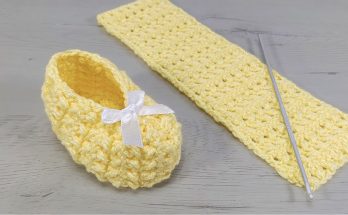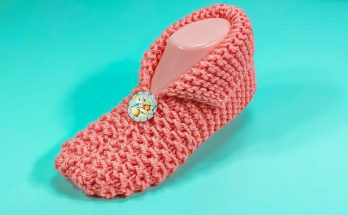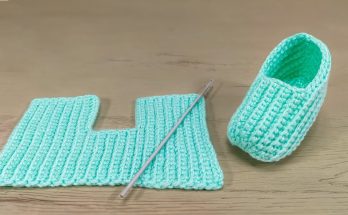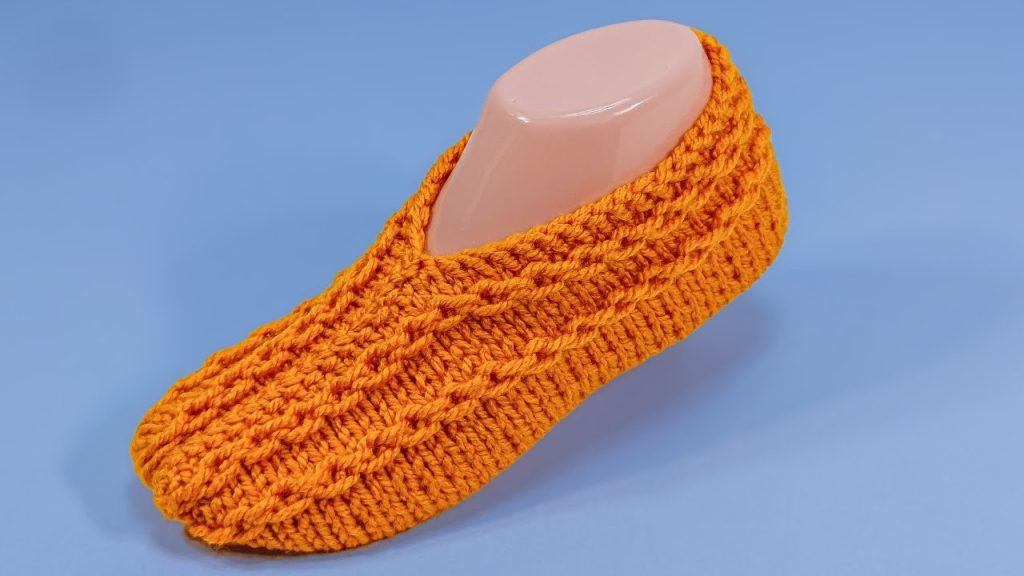
Welcome, knitters! Aren’t these slippers stunning? The vibrant orange color and the dense, intricate texture make them a luxurious treat for your feet. This stitch pattern—a variation of the Woven or Basket Stitch—provides fantastic cushioning and warmth while creating a fabric that is stable and durable enough for household wear.
This pattern is designed for Adult Medium (Women’s US size 7-9 / EU 38-40). It’s worked flat as a single piece, which is then seamed to form the shoe shape, resulting in that neat opening and rounded toe.
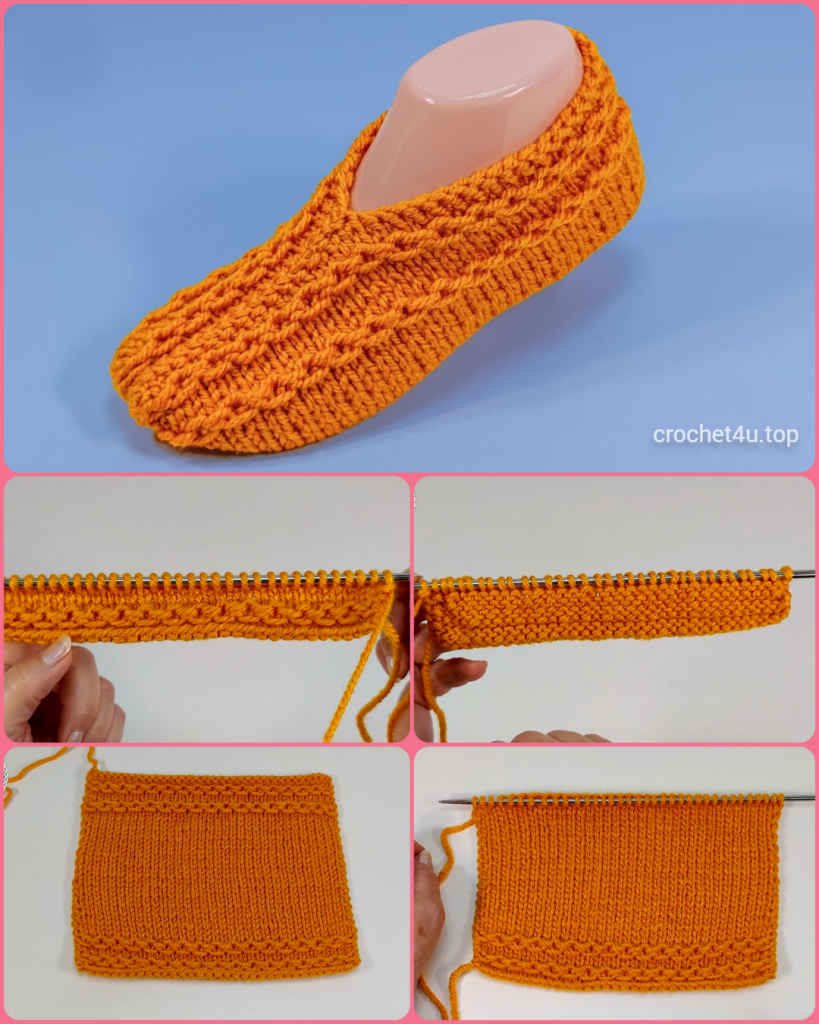
🛠️ Materials Needed
- Yarn: Approximately 150 – 180 yards (135 – 165 meters) of a soft, yet robust Worsted weight (Aran/10-ply) yarn.
- A wool or acrylic blend is ideal for resilience and warmth.
- Needles: A pair of US size 8 (5.0 mm) straight knitting needles.
- The dense stitch pattern benefits from a slightly larger needle size for flexibility.
- Notions:
- Tapestry Needle for seaming and weaving in ends.
- Scissors.
- Optional: A few stitch markers to keep track of the pattern repeat.
📏 Gauge (Crucial for Texture and Size)
- Gauge: 18 stitches and 28 rows equals 4 inches (10 cm) in the Woven Rib Stitch (see instructions below), measured after a light block or stretch.
- Note: This texture is very dense and will pull in considerably, so check your width and depth carefully.
ℹ️ Key Techniques & Abbreviations
The main body of this slipper relies entirely on the Woven Rib Stitch, a 4-row repeat that creates a beautiful, basket-like texture.
- K = Knit
- P = Purl
- st(s) = Stitch(es)
- RS = Right Side
- WS = Wrong Side
- K2tog = Knit two stitches together (a decrease).
- ssk = Slip, Slip, Knit (a decrease).
- Woven Rib Stitch: The 4-row repeat detailed below.
🧡 The Woven Rib Stitch (4-Row Repeat)
This pattern works best over a multiple of 2 stitches. The slipper pattern will use 44 stitches for the main body.
- Row 1 (RS): Knit all stitches.
- Row 2 (WS): P1, *K1, P1*. Repeat from * to * across the row. (1×1 Rib)
- Row 3 (RS): *K2, P2*. Repeat from * to * across the row. (2×2 Rib)
- Row 4 (WS): *P2, K2*. Repeat from * to * across the row. (2×2 Rib)
Note: The combination of garter stitch (Row 1) and the shifted ribs (Rows 2, 3, 4) creates that wonderful dense, textured fabric.
👣 The Pattern: Canyon Rib Slipper (Adult M)
This pattern is worked flat, beginning at the cuff/ankle opening.
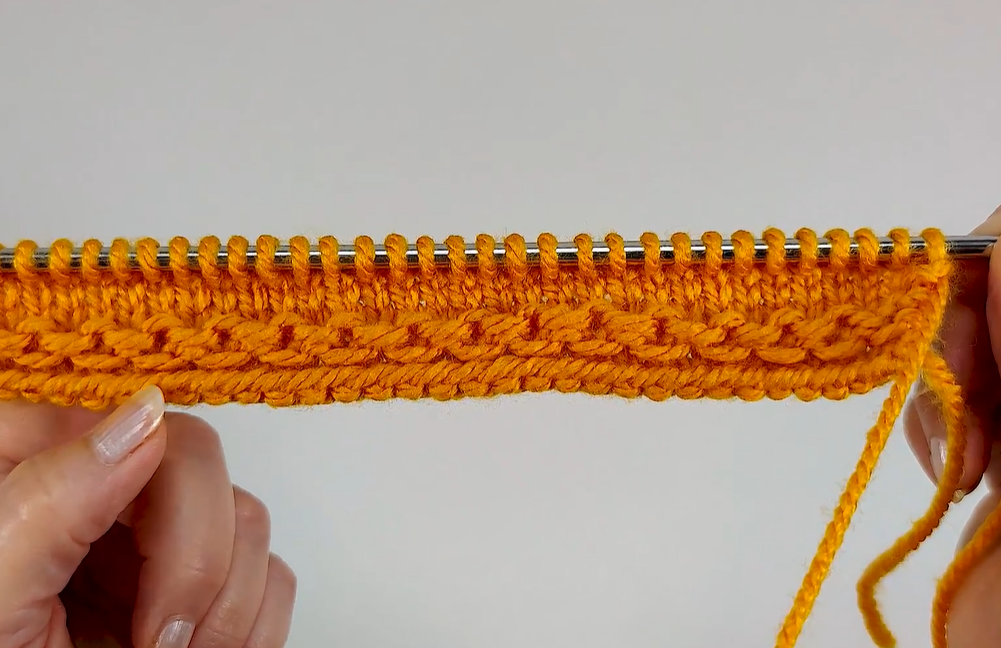
1️⃣ Cuff and Main Body
The body is worked entirely in the Woven Rib Stitch and is intentionally quite long to wrap around the entire foot.
| Step | Instructions | Stitch Count |
| Cast On | Cast on 44 stitches loosely. | 44 sts |
| Rows 1–8 | Cuff Edge: Work the Woven Rib Stitch (Rows 1–4) twice (8 rows total). This establishes the pattern and creates a sturdy top edge. | 44 sts |
| Rows 9–108 | Continue working the Woven Rib Stitch (Rows 1–4) for 100 more rows, or until the piece measures approximately 17 inches (43 cm) long. This length determines the circumference of your foot plus the length of your toe and heel. | 44 sts |
| End | End after completing a Row 4 (WS) of the repeat. | 44 sts |
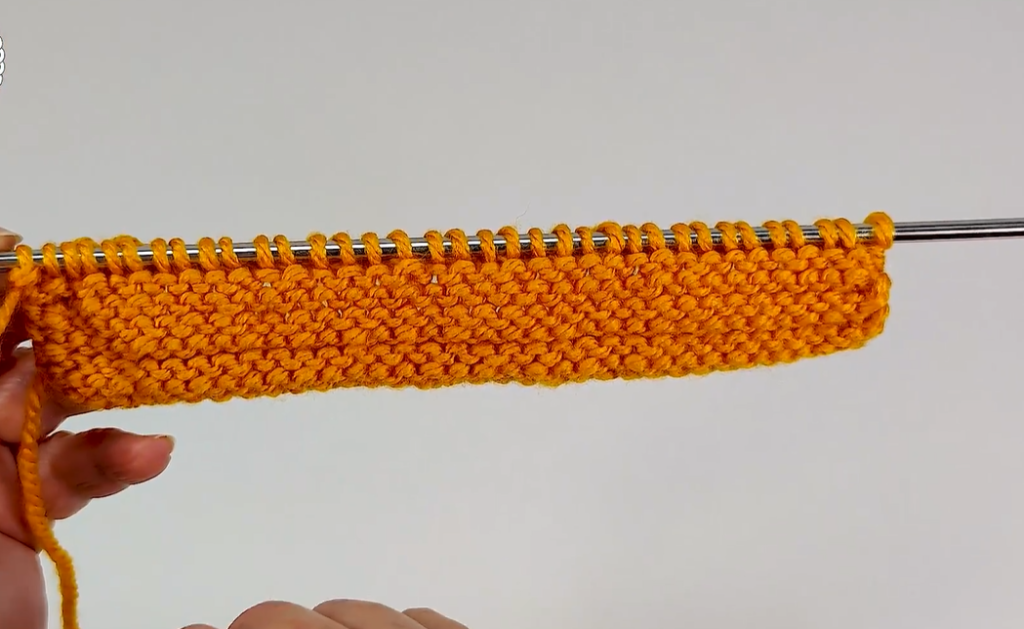
2️⃣ Toe Shaping
We will now decrease stitches at the toe-end only to create the rounded tip. The shaping will happen over the next 8 rows.
| Row | Instructions | Stitch Count |
| Row 109 (RS) | K2, K2tog, K to last 4 sts, ssk, K2. | 42 sts |
| Row 110 (WS) | Work Row 2 of Woven Rib Stitch (P1, *K1, P1*) across. | 42 sts |
| Row 111 (RS) | Work Row 3 of Woven Rib Stitch (*K2, P2*) across. | 42 sts |
| Row 112 (WS) | Work Row 4 of Woven Rib Stitch (*P2, K2*) across. | 42 sts |
| Row 113 (RS) | K2, K2tog, K to last 4 sts, ssk, K2. | 40 sts |
| Row 114 (WS) | Work Row 2 of Woven Rib Stitch across. | 40 sts |
| Row 115 (RS) | Work Row 3 of Woven Rib Stitch across. | 40 sts |
| Row 116 (WS) | Work Row 4 of Woven Rib Stitch across. | 40 sts |
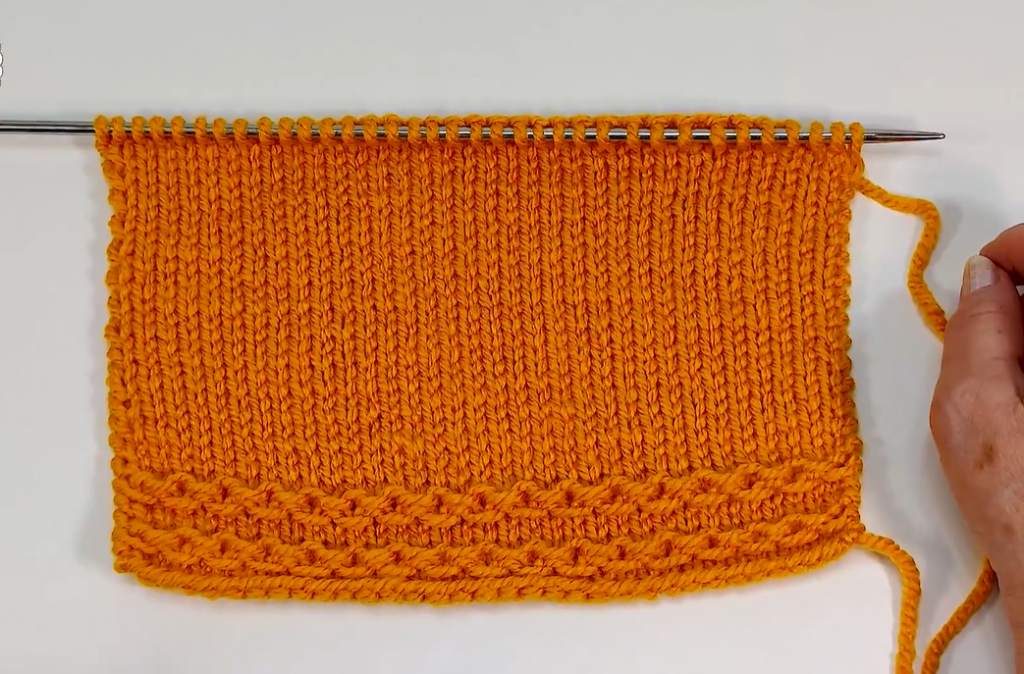
- Finishing Toe: Cut the yarn, leaving a long tail (about 24 inches / 60 cm). Thread the tail onto a tapestry needle.
🧵 Finishing and Seaming (The Transformation)
The unique shape of this slipper comes entirely from how the piece is folded and seamed.
- Closing the Toe Tip:
- Run the yarn tail through the loops of the remaining 40 stitches twice.
- Pull the tail tightly to cinch the toe opening closed, creating a neat, rounded point. Secure the thread on the inside with a firm knot.
- Seaming the Body:
- Fold the long knitted strip in half lengthwise. The cinched toe will be at one end.
- Starting at the cinched toe, use the mattress stitch to seam the entire sole edge, working all the way up to the cuff/cast-on edge.
- Creating the Opening:
- The seam runs from the tip of the toe, across the sole, and up the back of the heel. Stop seaming when you reach the point that creates the desired foot opening (about 3.5 inches / 9 cm down from the original cast-on edge).
- The unseamed section forms the V-shaped opening and the cuff around the ankle.
- Final Touches: Secure the yarn end at the top of the heel seam. Weave in all remaining tails on the inside of the slipper.
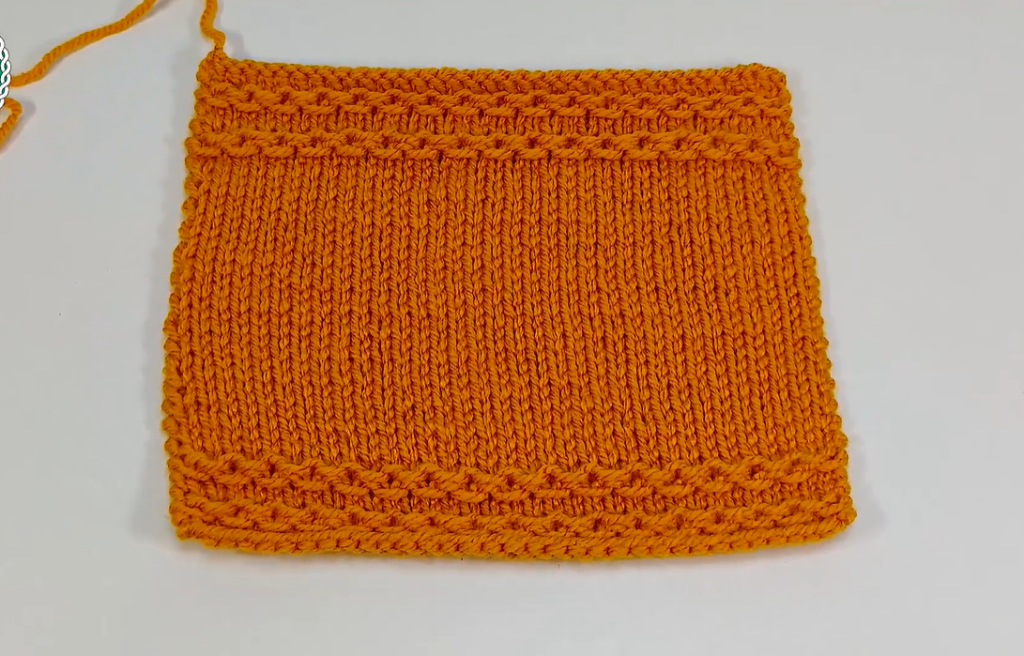
✨ Customization and Sizing
Adjusting the Length (Foot Size)
The total length of the piece (Rows 1–108) determines the total circumference (around the foot and its length).
- For Size S/M (US 5-6): Reduce the length of the main body (Rows 9–108) by approximately 12–16 rows.
- For Size L/XL (US 10-12): Increase the length of the main body (Rows 9–108) by approximately 12–16 rows.
Video Tutorial:
Adjusting the Width (Foot Girth)
The cast-on stitch count determines the height and width of the slipper.
- For a wider foot: Cast on 48 stitches (maintaining the multiple of 4).
- For a narrower foot: Cast on 40 stitches. You would then adjust the K2tog/ssk counts in the toe shaping accordingly.
Enhancing Durability
- Non-Slip Sole: Due to the dense texture, a simple rubberized sole finish works great. Apply a thin layer or dots of liquid latex or non-slip fabric paint to the bottom of the slipper and allow it to dry completely before use.
- Alternative Cuff: If you want a tighter edge around the ankle, after seaming, pick up stitches around the opening and knit 4 rows of 1×1 Rib on smaller needles (US 6/4.0 mm) before binding off.

